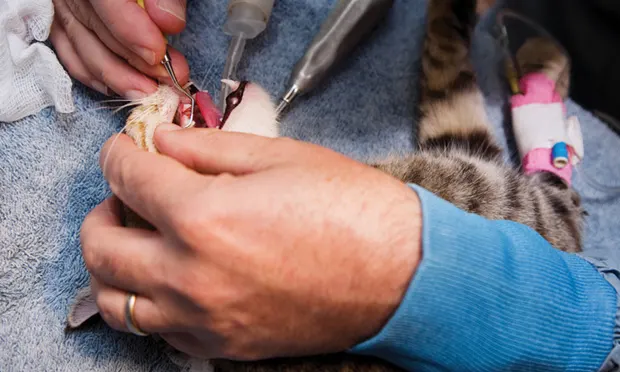Risk for Blindness after Anesthesia

Medical records of 20 cats with postanesthetic cortical blindness (± other neurologic signs) were reviewed to document vision and neurological abnormalities and identify risk factors for blindness following anesthesia.
Cats were anesthetized for dentistry (n = 13), endoscopy (n = 4), neutering (n = 2), and urethral obstruction (n = 1). A mouth gag was used in 16 cats. Three cats suffered cardiac arrest; the remaining had no identified potential anesthetic cause of blindness. Although 3 cats had blindness with no other neurologic abnormalities, the rest showed neurologic abnormalities (eg, circling, ataxia, head tilt, weakness, opisthotonos, decreased proprioception, abnormal mentation). Fourteen cats had documented recovery of vision, 4 remained blind, and 2 were lost to follow-up while still blind. Ten cats with neurologic deficits had full recovery, 2 had mild persistent deficits, 4 were lost to follow-up with no resolution of signs, and 1 was euthanized after failure to recover. Mouth gags were identified as a potential risk factor for cerebral ischemia and subsequent blindness. Investigators determined that wide jaw opening caused tension of the temporalis and masseter muscles, potentially compromising the maxillary artery, leading to ischemic necrosis causing blindness and other signs.
Decreased perfusion to the cerebral cortex via the maxillary artery is possible with mouth gags; maximal opening of the jaw should be short or avoided. Based on this study, prognosis for recovery from cortical blindness following anesthesia is good.
Commentary
Many potential causes for the postanesthetic cortical blindness in these cats were examined (eg, anesthetics, hypotension, cardiac arrest), but findings were largely attributed to spring-loaded mouth gags. Cadaveric dissections, although inconclusive, supported the theory that this type of mouth gag may compromise maxillary artery blood flow which, in turn, could result in cerebral hypoxia. Unfortunately, the study did not provide the prevalence of this occurrence during the evaluation but did report that 70% of cats regained vision and 59% of cats regained complete neurologic function. Until further data are available, one should be cautious not to overexpand the oral cavity when using a spring-loaded mouth gag.—Khursheed Mama, DVM, DACVAA
Source
Post-anesthetic cortical blindness in cats: Twenty cases. Stiles J, Weil AB, Packer RA, Lantz GC. VET J 193:367-373, 2012.